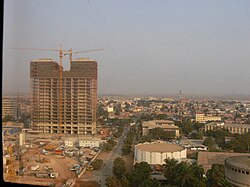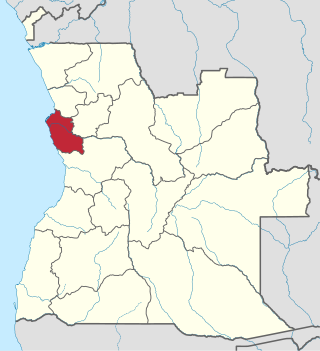
Luanda is a province of Angola. It covers an area of 18,835 km2, and had a population of 6,945,386 at the Census of 16 May 2014. The latest official estimate is 8,247,688.

Moxico or Moshiko is the largest province of Angola. It has an area of 223,023 square kilometres (86,110 sq mi), and covers 18% of the landmass of Angola. The province has a population of 758,568 and a population density of approximately 3.4 residents per km², making it one of the most sparsely populated areas of Angola. The population of the province is in flux; displaced residents have slowly returned to Moxico since the end of the Angolan Civil War in 2002. The war left Moxico as one of the most landmine-contaminated places in the world. The governor of the province is Gonçalves Manuel Muandumba.
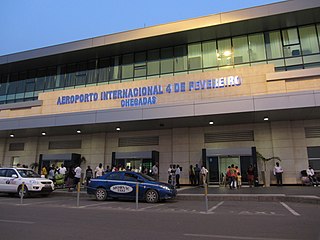
Quatro de Fevereiro International Airport, is the main international airport of Angola. It is located in the southern part of the capital Luanda, situated in the Luanda Province. Quatro de Fevereiro means 4th of February, which is an important national holiday in Angola, marking the start of the armed struggle against the Portuguese colonial regime on 4 February 1961. In 2009, about 1.8 million passengers were counted.
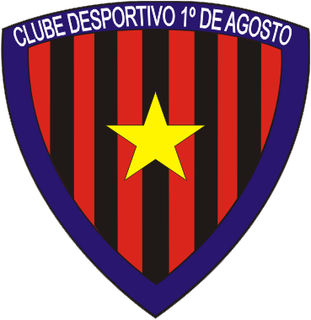
Clube Desportivo 1º de Agosto is a multisports club from Luanda, Angola. The club, founded 1 August 1977, is attached to the Angolan armed forces, which is its sponsor. Its main team competes in men's football, and its professional basketball team is also noteworthy within the club. The club's colors are red and black. The club won its first title in football, the Angolan League, in 1979. and in basketball in 1980. Handball and Volleyball have also won many titles to the club.

Girabola, or Campeonato Nacional de Futebol em Séniores Masculinos, is the top division of Angolan football. It is organized by the Angolan Football Federation.
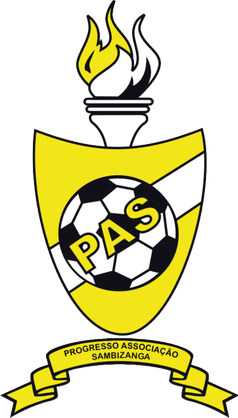
Progresso Associação do Sambizanga is an Angolan football club based in Luanda. The club was founded in 1975, as a result of a merger of three clubs: Juventude Unida do Bairro Alfredo(JUBA), Juventista and Vaza.
Pedro de Castro van Dúnem, also known as Comandante Loy, was an Angolan politician. He served in various leading functions within the MPLA during the Angolan liberation struggle against Portuguese colonial rule and within the country's government after achieving independence.

Sambizanga is one of the six urban districts that make up the municipality of Luanda, in the province of Luanda, Angola.

Ilha do Cabo typically known as Ilha de Luanda is a spit off the shore of Luanda, the capital of Angola, a country on the continents' southwestern coast. It consists of a low sandy strip formed by sedimentation. In administrative terms, the peninsula belongs to the municipality of Ingombota in the Luanda Province.
Ingombota is one of the six urban districts that make up the municipality of Luanda, in the province of Luanda, the capital city of Angola. Ingombota is home to the central business district of Luanda, Angola. The economic, political and symbolic center of the city and the nation, it is Luanda's oldest district. The district is home to most of Luanda's prominent hotels and office towers.

Rangel is one of the six urban districts that make up the municipality of Luanda, in the province of Luanda, the capital of Angola. The Rangel District is one of the older and more urbanized in Metropolitan Luanda. The district has an area of 6.2 square kilometers. The district is best known as the home of Americo Boavida University Hospital as well as several large sporting facilities including Pavilhão da Cidadela, Pavilhão Anexo and Pavilhão Anexo II.
Nelsa Alves is an Angolan model and was the competitor for Miss Universe 2009. She won the title of Miss Ingombota on her debut as a model, and subsequently sought to promote good causes.
The Municipality of Luanda is one of the nine municipalities that make up the province of Luanda, Angola. It covers roughly 116 km2 and includes Ilha de Luanda. The population was 2,194,747 at the 2014 census and is projected to be 2,571,861 in 2019 per Instituto Nacional de Estatística, República de Angola.
The 2002 Girabola was the 24th season of top-tier football competition in Angola. The season ran from 23 February to 20 October 2002. Petro de Luanda were the defending champions.
Fly540 Angola was a subsidiary of Fly540 that was based at Quatro de Fevereiro Airport in Luanda and Cabinda Airport in Cabinda, Angola. Parent company Fastjet suspended its operations in April 2014 pending restructuring, although it never resumed flights.
Maria de Fátima - better known by her pen name Cho do Guri - was an Angolan poet and writer.

The 2000 ASA Pesada Antonov An-24 crash occurred on 15 November 2000 when an Antonov An-24 registered as D2-FCG operated by Angolan airliner ASA Pesada crashed shortly after taking off from Quatro de Fevereiro Airport in Angola's capital Luanda. The aircraft was carrying 52 passengers and 5 crewmembers and was heading to Yuri Gagarin Airport in Namibe Province, Angola. All 57 people on board were killed in the crash.
The Luanda Light Rail is a proposed light rail line to be built in the Angolan capital city Luanda, at a projected cost of US $3 billion.
